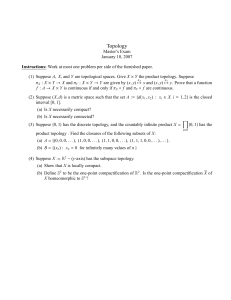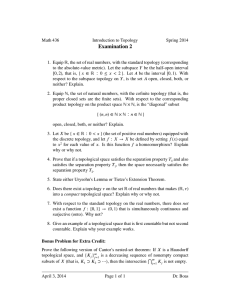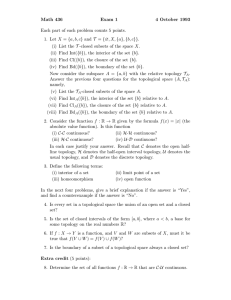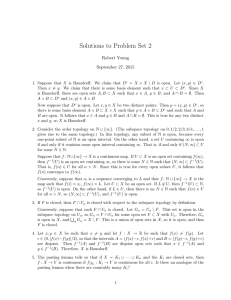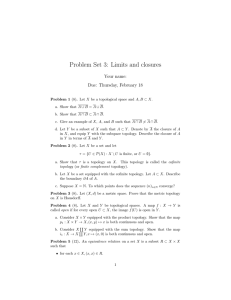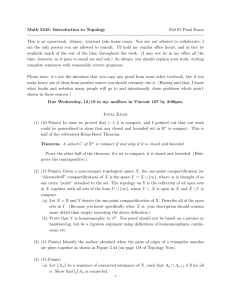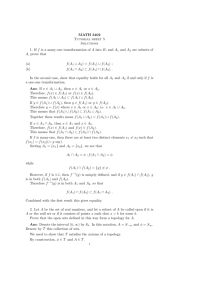Topology Midterm 4121/9021 – November 2014 Instructions: • Do
advertisement
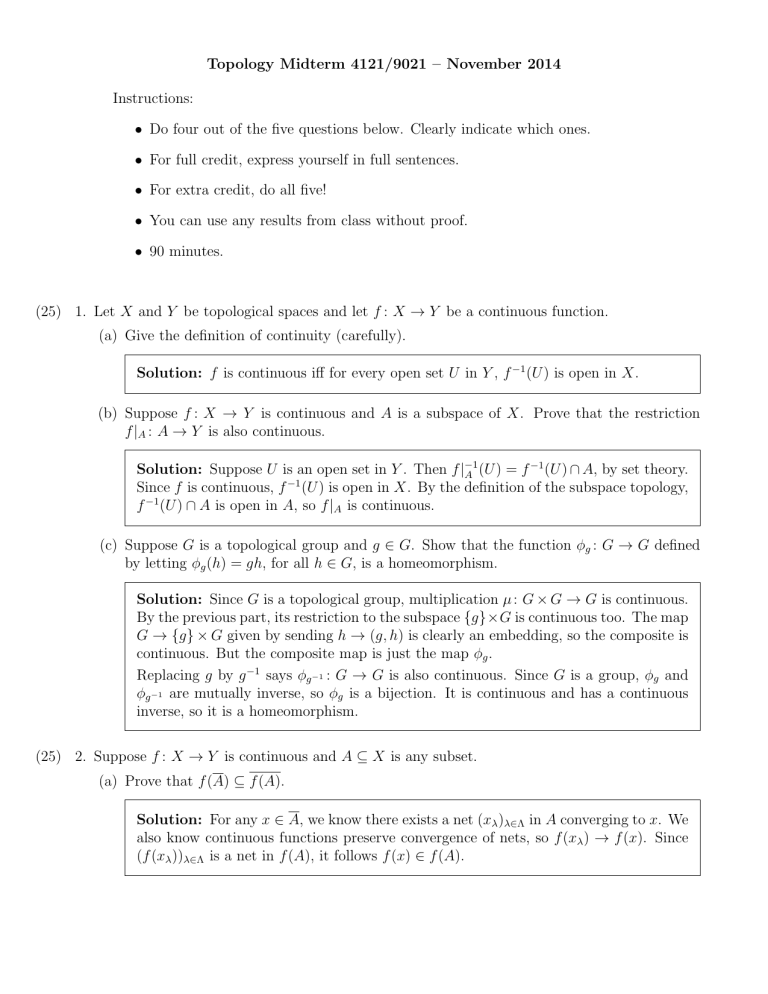
Topology Midterm 4121/9021 – November 2014
Instructions:
• Do four out of the five questions below. Clearly indicate which ones.
• For full credit, express yourself in full sentences.
• For extra credit, do all five!
• You can use any results from class without proof.
• 90 minutes.
(25) 1. Let X and Y be topological spaces and let f : X → Y be a continuous function.
(a) Give the definition of continuity (carefully).
Solution: f is continuous iff for every open set U in Y , f −1 (U ) is open in X.
(b) Suppose f : X → Y is continuous and A is a subspace of X. Prove that the restriction
f |A : A → Y is also continuous.
−1
Solution: Suppose U is an open set in Y . Then f |−1
(U ) ∩ A, by set theory.
A (U ) = f
−1
Since f is continuous, f (U ) is open in X. By the definition of the subspace topology,
f −1 (U ) ∩ A is open in A, so f |A is continuous.
(c) Suppose G is a topological group and g ∈ G. Show that the function φg : G → G defined
by letting φg (h) = gh, for all h ∈ G, is a homeomorphism.
Solution: Since G is a topological group, multiplication µ : G × G → G is continuous.
By the previous part, its restriction to the subspace {g}×G is continuous too. The map
G → {g} × G given by sending h → (g, h) is clearly an embedding, so the composite is
continuous. But the composite map is just the map φg .
Replacing g by g −1 says φg−1 : G → G is also continuous. Since G is a group, φg and
φg−1 are mutually inverse, so φg is a bijection. It is continuous and has a continuous
inverse, so it is a homeomorphism.
(25) 2. Suppose f : X → Y is continuous and A ⊆ X is any subset.
(a) Prove that f (A) ⊆ f (A).
Solution: For any x ∈ A, we know there exists a net (xλ )λ∈Λ in A converging to x. We
also know continuous functions preserve convergence of nets, so f (xλ ) → f (x). Since
(f (xλ ))λ∈Λ is a net in f (A), it follows f (x) ∈ f (A).
Mathematics 4121A/9021A
Midterm exam
6 November 2014
Solution: Alternatively, here’s a direct argument. If K is a closed set containing f (A),
by continuity, f −1 (K) is closed in X. Since f (A) ⊆ K, we have A ⊆ f −1 (K). From
the definition of closure, then, A ⊆ f −1 (K). Applying f shows f (A) ⊆ K.
But this was true for every closed set K containing f (A). So f (A) is contained in their
intersection, which is f (A).
(b) Suppose f is onto and A is dense in X. Prove that f (A) is dense in Y .
Solution: By definition, A = X. Using the previous part, we see f (X) ⊆ f (A) ⊆ Y .
Since f is onto, we have f (X) = Y . It follows that f (A) = Y too, which is to say f (A)
is dense in Y .
(25) 3. (a) Give the definition of a topology on a set X.
Solution: A topology is a subset τ ⊆ 2X for which
1. ∅ ∈ τ and X ∈ τ ;
2. Unions of elements of τ are in τ ;
3. Finite intersections of elements of τ are in τ .
(b) Give an example of a topological space and a collection of open sets whose intersection is
not open.
Solution: Consider the usual topology on R and note
is not an open set.
T
n≥1 (−1/n, 1/n)
= {0}, which
(25) 4. (a) Define what it means for a space X to be Hausdorff.
Solution: X is Hausdorff iff, for all x, y ∈ X, if x 6= y, then there exist open sets U
and V with x ∈ U , y ∈ V , and U ∩ V = ∅.
(b) Prove that, if x1 , x2 , x3 are three distinct points in a Hausdorff space X, there exist open
sets U1 , U2 , U3 in X with xi ∈ Ui for 1 ≤ i ≤ 3 and Ui ∩ Uj = ∅ for i 6= j.
Solution: Since X is Hausdorff, for each 1 ≤ i < j ≤ 3, there exist disjoint open sets
Ui,j and Uj,i with xi ∈ Ui,j and xj ∈ Uj,i .
Let U1 = U1,2 ∩ U1,3 , U2 = U2,1 ∩ U2,3 , and U3 = U3,1 ∩ U3,2 . For each i, we have xi ∈ Ui ,
because xi ∈ Ui,j for both j 6= i. We have U1 ∩U2 = U1,2 ∩U1,3 ∩U2,1 ∩U2,3 ⊆ U1,2 ∩U2,1 =
∅, because U1,2 and U2,1 were disjoint. By symmetry, U1 , U2 , U3 are pairwise disjoint.
(25) 5. Let X = {0, 1}R = {f : R → {0, 1}}. Give X a topology by putting the discrete topology on
{0, 1} and the product topology on X.
Page 2 of 3
Mathematics 4121A/9021A
Midterm exam
6 November 2014
(a) Write a basis for the topology on X (no explanation required.)
Solution: By definition of the product topology, a basis consists of all subsets
US,T = {f ∈ X : f (x) = 0 for x ∈ S and f (x) = 1 for x ∈ T }
where S, T are finite subsets of R.
(b) Suppose f : R → X is continuous. Prove it must be a constant function.
Solution: The trick is to remember that a map to a product is continuous if and only
if πx ◦ f is continuous for all coordinate projections πx : {0, 1}R → {0, 1}.
That is, for each x ∈ R, we need the function f (c)(x) : R → {0, 1} to be a continuous
function of c. The only such functions are constant functions. So for each x ∈ R, let
g(x) = f (c)(x), a number which does not depend on c. This is to say that f (c) = g for
all c; i.e., f is a constant function.
Page 3 of 3

